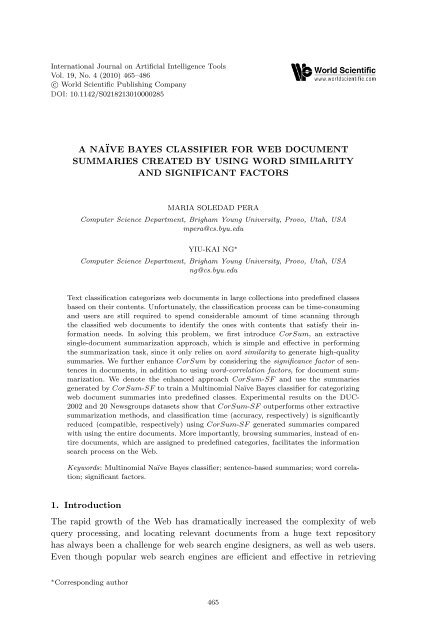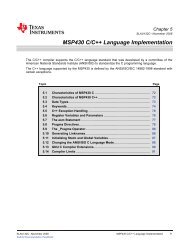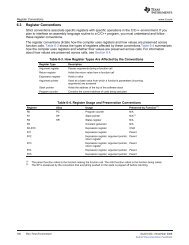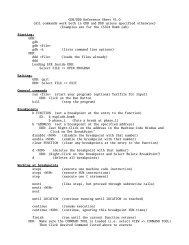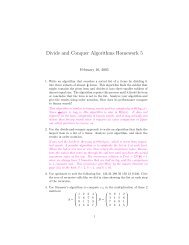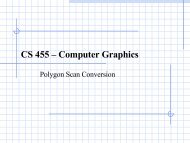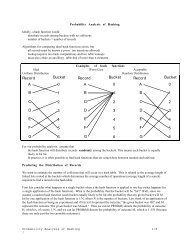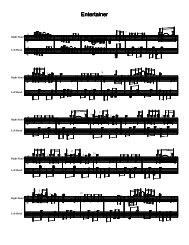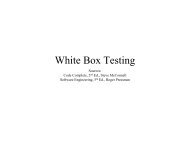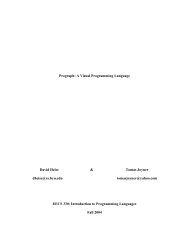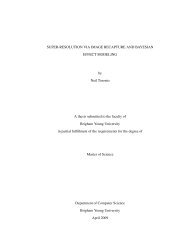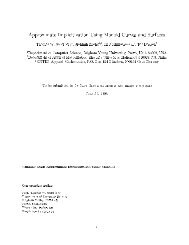A naïve Bayes Classifier for Web Document Summarie...
A naïve Bayes Classifier for Web Document Summarie...
A naïve Bayes Classifier for Web Document Summarie...
You also want an ePaper? Increase the reach of your titles
YUMPU automatically turns print PDFs into web optimized ePapers that Google loves.
International Journal on Artificial Intelligence ToolsVol. 19, No. 4 (2010) 465–486c○ World Scientific Publishing CompanyDOI: 10.1142/S0218213010000285A NAÏVE BAYES CLASSIFIER FOR WEB DOCUMENTSUMMARIES CREATED BY USING WORD SIMILARITYAND SIGNIFICANT FACTORSMARIA SOLEDAD PERAComputer Science Department, Brigham Young University, Provo, Utah, USAmpera@cs.byu.eduYIU-KAI NG ∗Computer Science Department, Brigham Young University, Provo, Utah, USAng@cs.byu.eduText classification categorizes web documents in large collections into predefined classesbased on their contents. Un<strong>for</strong>tunately, the classification process can be time-consumingand users are still required to spend considerable amount of time scanning throughthe classified web documents to identify the ones with contents that satisfy their in<strong>for</strong>mationneeds. In solving this problem, we first introduce CorSum, an extractivesingle-document summarization approach, which is simple and effective in per<strong>for</strong>mingthe summarization task, since it only relies on word similarity to generate high-qualitysummaries. We further enhance CorSum by considering the significance factor of sentencesin documents, in addition to using word-correlation factors, <strong>for</strong> document summarization.We denote the enhanced approach CorSum-SF and use the summariesgenerated by CorSum-SF to train a Multinomial Naïve <strong>Bayes</strong> classifier <strong>for</strong> categorizingweb document summaries into predefined classes. Experimental results on the DUC-2002 and 20 Newsgroups datasets show that CorSum-SF outper<strong>for</strong>ms other extractivesummarization methods, and classification time (accuracy, respectively) is significantlyreduced (compatible, respectively) using CorSum-SF generated summaries comparedwith using the entire documents. More importantly, browsing summaries, instead of entiredocuments, which are assigned to predefined categories, facilitates the in<strong>for</strong>mationsearch process on the <strong>Web</strong>.Keywords: Multinomial Naïve <strong>Bayes</strong> classifier; sentence-based summaries; word correlation;significant factors.1. IntroductionThe rapid growth of the <strong>Web</strong> has dramatically increased the complexity of webquery processing, and locating relevant documents from a huge text repositoryhas always been a challenge <strong>for</strong> web search engine designers, as well as web users.Even though popular web search engines are efficient and effective in retrieving∗ Corresponding author465
466 M. S. Pera & Y.-K. Ngin<strong>for</strong>mation from the <strong>Web</strong>, users must scan through the retrieved documents todetermine which ones are comparativelymore relevant than the others, which couldbe a time-consuming task. Hence, an advanced, scalable method that can identifythe content of web documents promptly is needed. This task can be accomplishedby creating a summary that captures the main content of a web document andreduces the time required <strong>for</strong> users to scan through the retrieved documents priorto exploring their full contents.Text classification can take advantages of summaries to further assist web usersin locating desired in<strong>for</strong>mation among categorized web documents with minimizedef<strong>for</strong>t, such as RSS news feed, since classified web document summaries on varioustopics provide a quick reference guide. Moreover, classifying summaries requiresonly a fraction of the processing time compared with classifying the entire documentsdue to the reduced size of the summaries.In this paper, we first introduce a simple and yet effective summarization technique,called CorSum, which is based on word similarity to extract sentences froma web document D that are representative of the content of D. Thereafter, we enhanceCorSum by considering the significance factor 20 of sentences in documents.The enhanced approach,called CorSum-SF, combines (i) the ranking scoreof eachsentence S in a document D computed by using word-correlation (i.e., similarity)factors, which establishes how similar S is with respect to the remaining sentencesin D, and (ii) the significance factor of S, which determines the proportion of significant,i.e., representative, words in S. Sentences in D with the highest combinedranking score and significant factor yield the summary of D.As opposed to other summarization approaches, CorSum-SF does not requireany training, is computational inexpensive, and relies solely on word/sentencesimilarity and significance factor to generate an accurate summary. In addition,CorSum-SF is easy to implement, since the word-correlation factors are precomputedand only addition, multiplication, and division are involved in computingsentence significance factors. CorSum-SF is not domain specific and thus can beapplied to generate summaries of documents with diverse structures and contents.Moreover, CorSum-SF can summarize multi-lingual document collections, if theproper word-correlation factors are available. We train a Naïve <strong>Bayes</strong> classifier,using CorSum-SF generated summaries to facilitate the classification of their correspondingweb documents, which speeds up the classification process with highaccuracy.The remaining paper is organized as follows. In Section 2, we discuss existingsummarizationandtextclassificationapproaches.InSection3,wepresentCorSum,introduce its enhanced version, CorSum-SF, and detail the classifier we adopt <strong>for</strong>text categorization. In Section 4, we evaluate the per<strong>for</strong>mance of CorSum-SF, inaddition to CorSum, and compare their per<strong>for</strong>mance with other summarizationapproaches. We also validate the efficiency and effectiveness of the chosen classifierusing CorSum-SF generated summaries <strong>for</strong> classification. In Section 5, we give aconclusion and directions <strong>for</strong> future work.
Classifying <strong>Summarie</strong>s of <strong>Web</strong> <strong>Document</strong>s 4672. Related WorkA significant number of text summarization methods have been proposed in thepast which apply different methodologies to per<strong>for</strong>m the summarization task. Asshown in Ref. 28, extraction, fusion, abstraction, and compression are four wellestablishedsummarization techniques. Extraction identifies representative sectionsof a text T which yield the summary of T, whereas fusion extracts and combinessentences in T to create revised sentences as the summary of T. Abstraction summarizesthe content of T with new concise sentences, and compression removessections in T that are considered relatively unimportant and retains the remainingsentences as the summary of T. In addition, existing summarization approachescan be grouped into two categories: single-document and multi-document. Singledocumentsummarization captures the main content of a document as its summary,whereas multi-document summarization creates a single summary <strong>for</strong> a documentcollection which describes the overall content of the collection coherently. 6 Radevet al. 28 claim that the extraction method <strong>for</strong> summarizing single documents is themost promising method, which is the strategy we adopt in our proposed summarizationapproach and is the focus of the subsequent discussion.Zhang and Li 35 introduce a summarization approach based on sentence clustering.Given a document D, Zhang and Li cluster similar sentences in D using thek-mean clustering algorithm. The similarity among any two sentences, s 1 and s 2 , iscomputed according to (i) the occurrence of the same words in s 1 and s 2 , (ii) thesimilarity between sequences of words in s 1 and s 2 , and (iii) the semantic similaritybetween s 1 and s 2 , which is determined using HowNet, an online knowledgebase <strong>for</strong> Chinese and English words. Thereafter, the sentence in each cluster withthe highest overall similarity with respect to the remaining sentences in the samecluster is selected to create the summary of D. Shen et al., 31 on the other hand,treat summarization as a sequence labeling problem and rely on the ConditionalRandom Fields algorithm to label sentences in a document D with a “1” or a “0”to indicate whether a sentence should or should not be included in the summaryof D, respectively. Even though CorSum-SF is an extractive, sentence-based summarizationapproach, CorSum-SF neither clusters sentences nor trains labelingalgorithms prior to selecting the sentences that should be included in a documentsummary, which reduces the summarization processing time.Fattah and Ren 8 develop a machine learning approach <strong>for</strong> text summarizationthat considers various features in a document, which include the (i) sentence position,(ii)positive/negativekeywordsinasentence,(iii)similaritybetweenasentenceand the document title, (iv) inclusion of numerical data in a sentence, (v) inclusionof named entities in a sentence, and (vi) sentence length. Each feature is used <strong>for</strong>trainingdifferent machinelearningalgorithms,suchasthe geneticalgorithm,neuralnetworks, probabilistic neural networks, and Gaussian Mixture Model, to generatetext summaries. Based on the conducted empirical studies, Fattah and Ren claimthat the Gaussian Mixture Model-based approach is the most effective algorithm<strong>for</strong> creating extractive summaries.
468 M. S. Pera & Y.-K. NgAntiqueira et al. 1 adopt metrics and concepts from complex networks to selectsentences in a document D that compose the summary of D. The authors representD as a graph in which sentences in D are denoted as nodes and sentences that sharecommon nouns are connected as edges. Thereafter, nodes in the graph are rankedaccording to various network measurements, such as the (i) number of nodes aparticular node is connected to, (ii) length of the shortest path between any twonodes,(iii)localityindex,whichidentifiescentralnodesinpartitiongroupsofnodes,and (iv) network modularity, which measures the proportion of edges connectingto intra-community a nodes, and the highest ranked nodes are chosen to create thecorresponding summary. Unlike the approach in Ref. 8, which depends on sentencebasedfeatures to train the proposed summarizer, or the approach in Ref. 1, whichreliesonnetwork-basedfeaturestocreatethesummaryofadocument,CorSum-SFrelies solely on the word-correlation factors among (the words in) sentences withina document D and the sentence significance factor to determine the sentences thatshould be included in the summary of D.The authors in Ref. 15 claim that many existing methodologies treat summarizationas a binary classification problem (i.e., sentences are either included orexcluded in a summary), which generates redundant, unbalanced, and low-recallsummaries. In solving this problem, Li et al. 15 propose a Support Vector Machinesummarization method in which summaries (i) are diverse, i.e., they include asfew redundant sentences as possible, (ii) contain (most of the) important aspectsof the corresponding documents, and (iii) are balanced, i.e., they emphasize differentaspects of the corresponding documents. By selecting the most representativesentences, CorSum-SF, similar to the approach in Ref. 15, creates summariesthat are balanced and diverse, but does not require previous training in generatingsummaries, and hence is less computationally expensive than the summarizationapproach in Ref. 15.Besides using text summarization <strong>for</strong> capturing the main content of web documents,constructed summaries can be further classified. Yang and Pedersen 34present several feature-selection approaches <strong>for</strong> text classification and compare theper<strong>for</strong>mance of two classifiers, K Nearest Neighbor (KNN) and Linear List SquaresFit mapping (LLSF). The classifiers compute the confidence score CS of a documentD in each category. CS in KNN is determined by the degrees of similarityof D with respect to the K nearest training documents in each category, whereasLLSF calculates CS of D in each category using a regression model based on thewords in D.McCallum and Nigam 22 discuss the differences between the Multi-variateBernoulli and Multinomial Naïve <strong>Bayes</strong> classifiers. Multi-variate Bernoulli representsa document D using binary attributes, indicating the absence and occurrencea The concept of communities is defined in Ref. 5 as sets of nodes that are highly interconnected,whereas other sets are scarcely connected to each other.
Classifying <strong>Summarie</strong>s of <strong>Web</strong> <strong>Document</strong>s 469of words in D, whereas the Multinomial classifier captures the content of D by thefrequency of occurrence of each word in D. Regardless of the classifier, the classificationis per<strong>for</strong>med by computing the posterior probability of each class given anunlabeled document D and assigning D to the class with the highest probability.Nigam et al. 25 rely on Maximum Entropy to per<strong>for</strong>m text classification. MaximumEntropy, which estimates probability distributions of data on a class-by-classbasis, represents a document D by its word count feature. Maximum Entropy assignsD to a unique class based on the frequency of occurrence of words in D thatis more alike to the word occurrence distribution of a particular class.Using the Dempster-Shafer Theory (DST), the authors of Ref. 29 combine theoutputs of several sub-classifiers (trained on different feature sets extracted fromthe same document collection C) and determine to which class a document inC should be assigned. As claimed by the authors, sub-classifiers reduce computationaltime without sacrificing classification per<strong>for</strong>mance, and DST fusion outper<strong>for</strong>mstraditional fusion methods, such as plain voting and majority weightedvoting.Unlike the methodologies adopted in Refs. 25, 29 and 34 in assigning (summarized)documents to their corresponding class, we depend on the MultinomialNaïve <strong>Bayes</strong> classifiers, which is one of the most widely-used and effective textclassifiers. 223. Summarization and ClassificationInthissection,wefirstdiscusstheoveralldesignofCorSum,whichusestheprecomputedword-correlation factors to identify representative sentences in a document Dto create the summary of D. Hereafter, we introduce CorSum-SF, which relies onsentence significance factors, in addition to word similarity, to improve the qualityof CorSum generated summaries. Furthermore, we present a Multinomial Naïve<strong>Bayes</strong> classifier, which we adopt <strong>for</strong> classifying CorSum-SF generated summariesof web documents in large collections.3.1. CorSum, a summarization approachMihalcea and Tarau 24 propose a sentence-extraction summarization method thatapplies two graph-based ranking algorithms, PageRank 3 and HITS, 11 to determinethe rank value of a vertex (i.e., a sentence in a document D) in a graph based on theglobal in<strong>for</strong>mation computed using the entire graph, i.e., the similarity of sentencepairs in D, which is calculated as a function of content overlap. Hereafter, sentencesare sorted in reversed order of their rank values, and the top-ranked sentences areincluded in the summary of D. CorSum also depends on ranked sentences, but therankvaluesarecomputedaccordingto(i) the word-correlation factors introducedinRef. 12, and (ii) the degrees of similarity of sentences. The highly ranked sentencesare the most representative sentences of D, which <strong>for</strong>m the summary of D.
470 M. S. Pera & Y.-K. Ng3.1.1. Word-Correlation factors and sentence similarityTheword-correlationmatrixM introducedinRef.12,whichincludesthecorrelationfactors of non-stop, stemmed words b , is a 54,625 × 54,625 symmetric matrix. Thecorrelation factor of any two words w i and w j , which indicates how closely relatedw i and w j are semantically, is computed based on the (i) frequency of co-occurrenceand (ii) relative distance of w i and w j in each document D in a collection and isdefined as follows:wcf(w i ,w j ) = ∑ ∑ 1(1)d(x,y)x∈V(w i) y∈V(w j)where d(x,y) denotes the distance (i.e., the number of words in) between x and yin D plus 1, and V(w i ) (V(w j ), respectively) is the set of words that include w i(w j , respectively) and its stem variations in D.Theword-correlationfactorsinM werecomputedusingtheWikipediaDatabaseDump (http://en.wikipedia.org/wiki/Wikipedia:Databasedownload), which consistsof 930,000 documents written by more than 89,000 authors on various topics,and hence is diverse in content and writing styles and is an ideal choice <strong>for</strong> measuringword similarity. Using the word-correlation factors in M, we compute thedegree of similarity of any two sentences S 1 and S 2 by adding the word-correlationfactors of each word in S 1 with every word in S 2 as follows:n∑ m∑Sim(S 1 ,S 2 ) = wcf(w i ,w j ) (2)i=1 j=1where w i (w j , respectively) is a word in S 1 (S 2 , respectively), n (m, respectively)is the number of words in S 1 (S 2 , respectively), and wcf(w i ,w j ) is defined inEquation 1.3.1.2. Most representative sentencesCorSum identifies sentences in a document D that most accurately represent thecontent of D during the summarization process. To determine which sentencesshould be included in the summary of D, CorSum computes the overall similarityof each sentence S i in D, denoted OS(S i ), with respect to the other sentences inD asn∑OS(S i ) = Sim(S i ,S j ) (3)j=1,j≠iwhere n is the number of sentences in D, S j is a sentence in D, and Sim(S i ,S j ) isdefined in Equation 2.b Stopwords are commonly-occurred words such as articles, prepositions, and conjunctions, whichare poor discriminators in representing the content of a sentence (or document), whereas stemmedwords are words reduced to their grammatical root. From now on, unless stated otherwise, wheneverwe refer to words, we mean non-stop, stemmed words.
Classifying <strong>Summarie</strong>s of <strong>Web</strong> <strong>Document</strong>s 471Fig. 1. A document D from the DUC-2002 dataset with (the most representative, highlighted)sentences extracted by CorSum to <strong>for</strong>m the summary of D.We rely on the Odds ratio, 10 which is defined as the ratio of the probability (p)that an event occurs to the probability (1 - p) that it does not, i.e., Odds = p1−p , tocompute the Ranking value of S i in D. We treat OS(S i ) as the positive evidenceof S i in representing the content of D. The Ranking value of S i , which determinesthe content significance of S i in D, such that the higher the ranking value of S i is,the more significant (content-wise) S i is in D, and is defined asRanking(S i ) = OS(S i)1−OS(S i ) . (4)Having computed the Ranking value of each sentence in D, CorSum choosesthe top N (≥ 1) ranked sentences in D as the most representative sentencesof D to create the summary of D. In establishing the proper value of N, i.e.,the number of representative sentences to be included in a summary, we followthe results of a study conducted by Ref. 23 on two different popular datasets,i.e., Reuters-21578 (http://archive.ics.uci.edu/ml/databases/reuters21578/) and<strong>Web</strong>KB (http://www.cs.umd.edu/ sen/lbc-proj/data/<strong>Web</strong>KB.tgz), using differentclassifiers, which concludes that in general a summary with six sentences can accuratelyrepresent the overall content of a document. More importantly, Mihalceaand Hassan 23 show in their study that using summaries with six sentences <strong>for</strong> clustering/classificationone can achieve the highest accuracy, an assumption we adoptin designing CorSum. If a document D contains less than six sentences, CorSumincludes the entire content of D as the summary of D.Example 1. Figure 1 shows a document D from the DUC-2002 dataset (to beintroduced in Section 4.1) in which the six most representative sentences (i.e., sentenceswith their Ranking values higher than the remaining ones) are highlighted,whereas Table 1 shows the Ranking values of the sentences in D and Table 2 includesthe degrees of similarity of the highest ranked (i.e., Sentence 10) and lowestranked (i.e., Sentence 11) sentences with the remaining sentences in D.
472 M. S. Pera & Y.-K. NgTable 1. Ranking values of the sentences in the documentshown in Figure 1.Sentence Ranking value Sentence Ranking value1 -1.100 7 -1.0472 -1.050 8 -1.0903 -1.050 9 -1.0554 -1.055 10 -1.0455 -1.070 11 -1.1426 -1.083Table 2. The degrees of similarity of Sentence 10 (thehighest ranked) and 11 (the lowest ranked) with respectto the others in the document shown in Figure 1.S i = 10 S i = 11S j Sim(S i ,S j ) S j Sim(S i ,S j )1 0.000007 1 1.0000012 2.000008 2 1.0000033 6.000005 3 0.0000014 3.000000 4 2.0000005 2.000003 5 0.0000016 0.000007 6 0.0000037 3.000004 7 1.0000018 2.000002 8 0.0000019 3.000001 9 1.00000111 1.000000 10 1.0000003.2. Enhancing CorSum using significance factorsTo further enhance the per<strong>for</strong>mance of CorSum, in terms of generating summariesthat accurately reflect the content of the corresponding documents, we rely on thesentence significance factor, which was first introduced in Ref. 20 and employed asa summarization strategy in Refs. 4 and 30. We have considered the significancefactor,sinceweembraceitsassumptionthatsentencesinadocumentD thatcontainfrequently occurring words in D tend to describe the content of D. The significancefactor <strong>for</strong> a sentence S is calculated based on the occurrence of significant words inS, i.e., words that are not stopwords and that have a frequency of occurrence in adocument between pre-defined high-frequency and low-frequency cutoffs values. 20As defined in Ref. 20, the significance factor <strong>for</strong> a sentence S in D, denoted SF(S),is computed asSF(S) =|Significant Words|2|S|where |S| is the number of non-stop words in S and |Significant Words| is thenumber of significant words in S. A word w in D is a significant word if⎧⎨7−0.1×(25−S D ) if S D < 25f D,w ≥ 7 if 25 ≤ S⎩D ≤ 40 (6)7+0.1×(S D −40) otherwise(5)
Classifying <strong>Summarie</strong>s of <strong>Web</strong> <strong>Document</strong>s 473where f D,w is the frequency of occurrence of w in D, S D is the number of sentencesin D, 25 is the low-frequency cutoff value, and 40 is the high-frequency cutoff value.Initial empirical studies conducted using the DUC-2002 dataset (to be introducedin Section 4.1) show that the significance factor by itself is not an effectivesummarization strategy. For this reason, we have developed CorSum-SF, an enhancedsummarization strategy which considers both the significance factor as wellas the ranking score of a sentence (as defined in Equation 4) in creating the summaryof a document.CorSum-SF combines the significance factor, denoted SF(S), and rankingvalue, denoted Ranking(S), of a sentence S in a document D to measure therelative degree of representativeness of S with respect to the content of D using theStan<strong>for</strong>d Certainty Factor, 19 denoted SCF. The <strong>for</strong>mal definition of SCF is givenas follows:SCF(R 1 )+SCF(R 2 )SCF(C) =(7)1−Min(SCF(R 1 ),SCF(R 2 ))where R 1 and R 2 are two hypotheses that reach the same conclusion C, and SCFis the Stan<strong>for</strong>d certainty factor (i.e., confidence measure) of C, which is a monotonicallyincreasing (decreasing) function of combined assumptions <strong>for</strong> computingthe confidence measure of C.Based on SCF, the combined SF(S) and Ranking(S) yields our content reflectivityscore of S, denoted Con Ref(S), as defined below.Con Ref(S) =Ranking(S)+SF(S)1−Min(Ranking(S),SF(S)) . (8)Using the Con Ref value of each sentence in D, CorSum-SF selects the top sixsentences with the highest Con Ref values (as the most representative sentencesin D) to create the corresponding summary of D.3.3. The Naïve <strong>Bayes</strong> classifierTo verify that classifying text documents using their summaries, instead of theentire documents, is cost-effective, we apply a Naïve <strong>Bayes</strong> classifier, which is oneof the most popular text classification tools, since Naïve <strong>Bayes</strong> is simple, easy toimplement, robust, highly scalable, and domain independent, 13 and thus is an idealchoice <strong>for</strong> classifying summaries generated by CorSum-SF. Moreover,even thoughNaïve <strong>Bayes</strong> assumes mutual independence of attributes, it achieves high accuracyin text classification. 22Among the variants of the Naïve <strong>Bayes</strong> classifier, we choose the multinomialimplementation of the Naïve <strong>Bayes</strong> classifier, 22 denoted MNB, since, as previouslystated, MNB is one of the most widely-used text classifiers. 13 MNB uses the frequencyof word occurrence to compute the probability of a document to be assignedto a particular class. During the training process, MNB first estimates the probabilityof a word w t in a natural class c j , which is based on the frequency of occurrenceof w t in each pre-classified, labeled document d i , i.e., a summary generated by
474 M. S. Pera & Y.-K. NgCorSum-SF in our case, in a collection of documents CD, and is <strong>for</strong>mally definedasP(w t |c j ) =1+ ∑ |CD|i=1 N itP(c j |d i )|V|+ ∑ |V|s=1∑ |CD|i=1 N isP(c j |d i )where N it (N is , respectively) denotes the frequency of occurrence of w t (word w s ,respectively) in d i , |CD| is the number of documents in CD, |V| is the number ofdistinct words in CD, and P(c j |d i ) is 1, if c j is the pre-assigned class of d i , i.e., d iis pre-assigned to c j , and 0, otherwise.Having determined the required probabilities during the training step of MNB,the probability that a given (unlabeled) document d k belonged to the class c j ,denoted P(d k |c j ), is computed at the classification phase as|V|∏ P(w t |c j ) N ktP(d k |c j ) = P(|d k |)|d k |!N kt !where |d k | denotes the number of words in d k , |V|, N kt , and P(w t |c j ) are as definedin Equation 9, and the probability of a document d k in CD is defined as|C|t=1(9)(10)∑P(d k ) = P(c j )P(d k |c j ) (11)j=1where |C| is the number of predefined natural classes, P(c j ) is the fraction ofdocuments in CD that belong to c j , which is determined at the training phase, andP(d k |c j ) is as computed in Equation 10.In classifying d k , i.e., a summary in our case, MNB assigns to d k the class labelc j , if the computed probability P(c j |d k ) is the highest among all the probabilitiesP(c i |d k ) <strong>for</strong> each predefined natural class c i . P(c j |d k ) is computed as follows, whichis the well-known <strong>Bayes</strong>’ Theorem:P(c j |d k ) = P(c j)P(d k |c j )P(d k )where P(d k |c j ), P(d k ), and P(c j ) are as defined earlier.During the implementation process of MNB, the probability of a word in agiven class is smoothed by using the Laplace approach, also-known as add-onesmoothing, 22 which adds the values 1 and |V| as shown in Equation 9. Probabilitysmoothing is often applied to solve the zero-probability problem that occurs when aword not seen during the training process is in a document to be classified. 27,33(12)4. Experimental ResultsIn this section, we describe the datasets used <strong>for</strong> experimentation and present theevaluation measures which are adopted <strong>for</strong> (i) quantifying the quality of summariesgeneratedbyCorSum(-SF), (ii)comparingtheper<strong>for</strong>manceofCorSum(-SF)withother well-knownextractive summarizationapproaches,and (iii) demonstrating the
Classifying <strong>Summarie</strong>s of <strong>Web</strong> <strong>Document</strong>s 475effectiveness and efficiency of using an MNB <strong>for</strong> classifying summaries generatedby CorSum(-SF), instead of the entire documents.4.1. DatasetsWe assess and compare the per<strong>for</strong>mance of CorSum(-SF) utilizing the widelyused<strong>Document</strong> Understanding Conference (DUC) 2002 dataset (http://wwwnlpir.nist.gov/projects/duc/pastduc/duc2002/data.html). DUC-2002 includes 533news articles divided into 60 clusters, each containing approximately 10 articles retrievedfrompopularnewscollectionssuchastheWallStreetJournal,APNewswire,Financial Times, and LA Times. The dataset also includes two summaries, calledreference summaries, created by human experts <strong>for</strong> each news article, based onwhich the per<strong>for</strong>mance of any single-document or multi-document summarizationapproachcan be evaluated. We comparethe CorSum(-SF) generatedsummariesofthe DUC-2002 news articles with the corresponding reference summaries in termsof their overlapping content.To determine the suitability of using summaries, instead of the entire documents,in text classification, we applied the MNB classifier on the 20 Newsgroup(http://kdd.ics.uci.edu/databases/20newsgroups/20newsgroups.html) dataset, denoted20NG, from where CorSum(-SF) generated summaries are created. We relyon 20NG <strong>for</strong> evaluating the per<strong>for</strong>mance of the MNB classifier using summaries(generated by CorSum or CorSum-SF), since 20NG is a popular news documentcollection used <strong>for</strong> verifying the accuracy of text classification or text clusteringtools. The 20NG dataset 14 consists of 19,997 articles retrieved from the Usenetnewsgroup collection that are clustered into 20 different categories. For evaluationpurpose, 80% of the documents in 20NG were used <strong>for</strong> training MNB, and theremaining 20% <strong>for</strong> classification evaluation.4.2. Evaluation measuresTo evaluate the per<strong>for</strong>mance of CorSum and CorSum-SF, we have implementeda widely used summarization measure, the Recall-Oriented Understudy <strong>for</strong> GistingEvaluation (ROUGE). 16 ROUGE includes measures that quantify the quality ofa summary S created using a summarization approach by comparing the numberof overlapping units, such as n-gram, word sequences, or word pairs, in S withthe ones in the expert-created reference summaries of the same document. Fourdifferent ROUGE measures are known <strong>for</strong> summarization evaluation: ROUGE-N,ROUGE-L, ROUGE-W, and ROUGE-S, which are based on n-gram overlap, leastcommonsubstrings, weighted least-common substrings, and skipping bigrams cooccurrence,respectively. We have considered ROUGE-N, as opposed to the otherROUGE variations, since as shown in Ref. 16, the unigram-based ROUGE-N score,i.e., ROUGE-1, is the most accurate measure <strong>for</strong> establishing the closeness betweenautomatically-generated summaries and their corresponding reference summaries.In addition, ROUGE-N (<strong>for</strong> N = 1 and N = 2) is the most ideal choice
476 M. S. Pera & Y.-K. Ng<strong>for</strong> evaluating short summaries and single-document summaries. 16 ROUGE-N ofan automatically-generated summary S is defined as∑ ∑ROUGE-N =HS∈Reference <strong>Summarie</strong>s gram n ∈HS Count match(gram n )∑ ∑HS∈Reference <strong>Summarie</strong>s gram n ∈HS Count(gram n)where gram n is an n-gram, Count match (gram n ) is the number of common n-gramsin S and in one of the reference summaries HS of S, and Count(gram n ) is thenumber of n-grams in HS.We have used ROUGE-1 and ROUGE-2, i.e., compared the unigram andbigram overlap between S and HS, respectively, to assess the per<strong>for</strong>mance ofCorSum(-SF) and other summarization techniques.Toevaluatetheper<strong>for</strong>manceofMNBonsummaries,insteadofthecorrespondingentire documents, we use the classification accuracy measure as defined below.Accuracy =(13)Number of Correctly Classified <strong>Document</strong>sTotal Number of <strong>Document</strong>s in a Collection . (14)4.3. Per<strong>for</strong>mance evaluation of CorSum(-SF)We have verified the effectiveness of CorSum(-SF) based on the ROUGE-1 andROUGE-2evaluationmeasures,whichdeterminethenumberofoverlappedn-grams(1 ≤ n ≤ 2) in each summary generated by CorSum(-SF) and one of the correspondingreference summaries. Table 3 shows the ROUGE-1 and ROUGE-2 valuescomputed using summaries generated by CorSum(-SF) on a number of documentsin the DUC-2002 dataset.Onan average,CorSum obtained0.54(0.28,respectively)ROUGE-1(ROUGE-2, respectively) value, which implies that 54% (28%, respectively) of the unigrams(bigrams, respectively) in a reference summary are included in its correspondingCorSum generated summary. The ROUGE-1 (ROUGE-2, respectively) value ofCorSum generated summaries is increased by another 5% (4%, respectively) by itsCorSum-SF counterpart. ROUGE-1 is almost twice as high as ROUGE-2,which isanticipated, since ROUGE-1 considers overlapped unigrams which includes overlapof stopwords in the summaries, whereas bigrams limit the extent of overlapbetweentwo summaries as a result of matching two adjacent words, which is lower in probabilitythan matching two single words. More importantly, as previously stated, wecompare summaries generated by CorSum(-SF) with reference summaries, thatare not extractive, which were created by human experts using new sentences thatcapture the gist of the test documents. For this reason, achieving high ROUGE-1 and ROUGE-2 values is not a simple task. A high ROUGE-N value providesfurther evidence of the high quality of CorSum(-SF) generated summaries comparedwith other summarization methods (as shown in Section 4.3.1), even thoughCorSum(-SF) generated summaries are extractive and its creation process is relativelysimple and straight<strong>for</strong>ward compared with the rewriting approach.
Classifying <strong>Summarie</strong>s of <strong>Web</strong> <strong>Document</strong>s 477Table 3. The overall ROUGE-1 and ROUGE-2 averages and theROUGE-1 and ROUGE-2 values of a number of summaries generated byCorSum and CorSum-SF on the documents in DUC-2002, respectively.CorSumCorSum-SF<strong>Document</strong> Name ROUGE-1 ROUGE-2 ROUGE-1 ROUGE-2AP900625-0036 0.51 0.18 0.53 0.19AP900625-0153 0.21 0.16 0.34 0.16AP000626-0010 0.48 0.28 0.54 0.32AP900705-0149 0.94 0.45 0.86 0.39AP900730-0116 0.71 0.48 0.71 0.48AP901123-0002 0.38 0.13 0.52 0.18... ... ... ... ...Overall Average 0.54 0.28 0.59 0.32Fig.2. A reference summary of the sample document in Figure 1 with (highlighted) unigrams and(underlined, sequence of) bigrams overlapped with the ones in the CorSum generated summary.Example 2. Figures 1 and 2 show the CorSum generated summary CS and oneof its corresponding reference summary RS in the DUC-2002 dataset, respectively.Out of the 99 wordsin RS, 80of its unigramsand 41of its bigrams arein CS. Somesentences in RS have been rephrased and include synonyms of words used in theoriginal document d, which result in mismatched unigrams and bigrams betweenCS and RS. However, CorSum extracts sentences in d that are highly similar tothe ones in RS and achieves higher ROUGE-N values compared with other existingsummarization approaches, which have been verified.(See experimental resultspresented in the next subsection.)4.3.1. Comparing the per<strong>for</strong>mance of CorSum(-SF)To further assess the effectiveness of CorSum and CorSum-SF on summarization,we compared their per<strong>for</strong>mance, in terms of ROUGE-1 and ROUGE-2 measures,with other well-established summarization approaches that adopt differentmethodologies <strong>for</strong> text summarization using the DUC-2002 dataset. The varioussummarization strategies to be compared include the ones implemented in Collab-Sum, 32 i.e., Uni<strong>for</strong>m-Link, Union-Link, Inter-Link, and Intra-Link, which rely oninter- and intra-document relationships in a cluster to generate a summary, the
478 M. S. Pera & Y.-K. NgLatent Semantic Analysis (LSA) summarization method in Ref. 9, and the Top-Nmethod in Ref. 26. We also compare the per<strong>for</strong>mance of CorSum(-SF) with theones in Refs. 2, 7, 17, 18 and 21.The Top-N summarizer 26 is considered a naive summarization approach, whichextracts the first N (≥ 1) sentences in a document D as its summary and assumesthat introductory sentences contain the overall gist of D.Gong 9 applies Latent Semantic Analysis (LSA) <strong>for</strong> summarization. LSA firstestablishes (i) inter-relationships among words in a document D by clusteringsemantically-related words and sentences in D and (ii) word-combination patternsthat recur in D which describe a topic or concept. LSA selects the highest-scoredsentences that contain recurring word patterns in D to <strong>for</strong>m the summary of D.CollabSum in Ref. 32 creates the summary of D using sentences in D and documentsin the cluster to which D belongs. To create the summary of D, CollabSumrelies on (i) Inter-Link, which captures the cross-document relationships of a sentencewith respect to the others in the same cluster, (ii) Intra-Link, which reflectsthe relationships among sentences in a document, (iii) Union-link, which is basedon the inter- and intra-document relationships R, and (iv) Uni<strong>for</strong>m-Link, whichuses a global affinity graph to represent R.Martins and Smith 21 create sparse summaries, each of which contains a smallnumber of sentences that reflect representative in<strong>for</strong>mation in a document. InRef. 21 summarization is treated as an integer linear problem and an objectivefunction is optimized which incorporates two different scores, one reflecting thelikelihood of selecting a sentence S to be part of a summary and another the compressionratio of S. Given a document D, the subset of sentences in D that maximizesthe combined objective function score yields the summary of D. The authorsof Ref. 21 consider both unigrams and bigrams in compressing sentences, and theconducted empirical study shows that unigrams achieve the highest per<strong>for</strong>mance intext summarization.Dunlavy et al. 7 rely on a Hidden Markov Model (HMM) to create the summaryof a document, which consists of the top-N sentences with the highest probabilityvalues offeaturescomputed usingthe HMM. The features used in the HMM include(i) the number of signature terms in a sentence, i.e., terms that are more likely tooccur in a given document rather than in the collection to which the documentbelongs, (ii) the numberof subject terms, i.e., signatureterms that occur in headlineor subject leading sentences, and (iii) the position of the sentence in the document.Since the HMM tends to select longer sentences to be included in a summary, 7sentences are trimmed by removing lead adverbs and conjunctions, gerund phrases,and restricted relative-clause noun phrases.Binwahlan et al. 2 introduce a text summarization approach based on a particleswarm optimization which determines the weights to be assigned to each of thefollowing text features: (i) common number of n-grams between a given sentenceand the remaining sentences in the same document, (ii) word sentence score, whichis computed using the TF-IDF weights ofwordsin sentences, and (iii) sentence sim-
Classifying <strong>Summarie</strong>s of <strong>Web</strong> <strong>Document</strong>s 479ilarity score, which establishes the similarity between a given sentence and the firstsentence of a document. Based on the extracted features and their correspondingweights, each sentence in a document D is given an overall score and the highestscoredsentences are included in the summary of D.As defined in Ref. 17, words with high quantity of in<strong>for</strong>mation often carry morecontent and are more important. In summarizing documents, Liu et al. 17 considerthe in<strong>for</strong>mation captured in a word by measuring the importance, i.e., significance,of each word in a sentence using word in<strong>for</strong>mation and entropy models. Givena document D, each sentence S in D is ranked using a score that is computedaccording to the position of S in D, as well as the significance of words in S, andthe highest ranked sentences are included in the summary of D.Lloret and Palomar 18 consider (i) word frequency, (ii) textual entailment, whichis a natural language processing task that determines whether a text segment (ina document) can be inferred by others, and (iii) the presence of noun phrases tocompute a score <strong>for</strong> each sentence in a document D. Lloret and Palomar extractsentences in D with the highest scores, which are treated as the most effectiverepresentation of the content of D, to generate the summary of D.As shown in Figure 3, CorSum-SF outper<strong>for</strong>ms all of these summarizationapproaches by 9-26% (10-14%, respectively) based on unigrams (bigrams, respectively),which verifies that CorSum-SF generated summaries are more reliable incapturing the content of documents than their counterparts.4.3.2. Observations on the summarization resultsThe summarization approachbased on LSA 9 choosesthe most in<strong>for</strong>mative sentencein a document D <strong>for</strong> each salient topic T, which is the sentence with the largestindex value on T. The drawback of this approach is that sentences with the largestindex values of a topic, which may not be the overall largest among all topics, arechosen even if they are less descriptive than others in capturing the content of D.The Top-N (= 6, in our study) summarization approach is applicable to documentsthatcontainanoutlinein the beginningparagraph.As showninFigure3,theTop-N summarizer achieves relatively high per<strong>for</strong>mance, even though its accuracyis still lower than CorSum(-SF), since the news articles in DUC-2002 dataset arestructured such that the first few lines of each article often contain an overall gist ofthe article. However, the Top-N approach is not suitable <strong>for</strong> summarizing generaltext collections with various document structures, as opposed to CorSum(-SF)which is domain-independent.Since the summarization approaches in CollabSum, i.e., Inter-Link, Intra-Link,Uni<strong>for</strong>m-Link, and Union-Link, 32 must capture the inter- and intra-document relationshipsof documents in a cluster to generate the summary of a document,this process increases the overall summarization time. More importantly, inter- andintra-document in<strong>for</strong>mation used by CollabSum are not as sophisticated as theword-correlation factors used by CorSum(-SF) in capturing document contents,
480 M. S. Pera & Y.-K. NgFig. 3. ROUGE-N values achieved by different summarization approaches on DUC-2002.since CollabSum approaches yield lower ROUGE-N values than CorSum(-SF) (asshown in Figure 3).Unlike the summarization methods in (i), 21 which requires training the compressionand selection models as a pre-processing step, (ii), 7 which uses a supervisedlearningapproach,and (iii), 2 which learns from a particle swarm optimizationmodel, neither CorSum nor CorSum-SF require any training step <strong>for</strong> documentsummarization.The summarization methods in Refs. 17 and 18 depend solely on the wordsignificance value of a word w in a sentence S and the word frequency of w, respectively.Contrarily, besides the significance factor of w in S, CorSum-SF usesword-correlation factors to determine the ranking score of S.4.4. Classification per<strong>for</strong>mance evaluationWe have evaluated the effectiveness and efficiency of classifying summaries, as opposedto entire documents, using MNB on the 20NG dataset. Figure 4 shows theclassification accuracyachievedby MNB using automatically-generatedsummaries,as well as the entire content, of the documents in 20NG <strong>for</strong> comparison purpose.Using CorSum generated summaries, MNB achieves a fairly high accuracy, i.e.,
Classifying <strong>Summarie</strong>s of <strong>Web</strong> <strong>Document</strong>s 481Fig. 4. Accuracy ratios and processing time achieved by MNB using automatically-generatedsummaries, as well as the entire content, of articles in the 20NG dataset.74%, even though using the entire documents MNB achieves a higher classificationaccuracy of 82%, which is less than 10% difference. However, the training andclassification processing time of MNB is significantly reduced when using CorSumgenerated summaries as opposed to the entire documents as shown in Figure 4— the processing time required <strong>for</strong> training the MNB classifier and classifying onentire documents is reduced by more than 60% when using CorSum generatedsummaries.By using CorSum-SF, instead of CorSum, to summarize documents in the20NG dataset, the classification accuracy on training and testing (CorSum-SF)summariesis increasedby 4%, which means that MNB achieves78% accuracywhenclassifying CorSum-SF generated summaries. More importantly, the classificationaccuracyusing CorSum-SF is only 4% lowerthan the one achievedusing the entiredocumentsonthe20NGdataset,whilethetrainingandtestingtimearesignificantlyreduced by almost two-thirds compared with using the entire documents.In comparing with the classification accuracy of Top-N and LSA summaries,CorSum(-SF) outper<strong>for</strong>ms both of them. This is because using summaries generatedby CorSum(-SF), MNB can extract more accurate in<strong>for</strong>mation based onthe probability of words belonged to different classes (as computed in Equation 9)in a labeled document collection, which translates into fewer mistakes during the
482 M. S. Pera & Y.-K. NgFig. 5. Accuracy ratios <strong>for</strong> CorSum and CorSum-SF generated summaries.classification process. Furthermore, on the average MNB per<strong>for</strong>ms classification atleast as fast as using the summaries generated by CorSum(-SF) than the LSA orTop-N summaries as shown in Figure 4.In Figure 5, we show the classification accuracy using MNB on CorSum(CorSum-SF, respectively) generated summaries <strong>for</strong> each natural class in20NG, and the corresponding labeled classes are (1) sci.electronics, (2)comp.sys.mac.hardware, (3) soc.religion.christian, (4) comp.windows.x, (5)comp.sys.ibm.pc.hardware,(6) comp.graphics, (7) misc.<strong>for</strong>sale,(8) rec.motorcycles,(9) comp.os.ms-windows.misc, (10) rec.sport.hockey, (11) talk.politics.misc, (12)alt.atheism, (13) sci.crypt, (14) talk.politics.guns, (15) rec.sport.baseball, (16)sci.space, (17) talk.politics.mideast, (18) sci.med, (19) rec.autos, and (20)talk.religion.misc. Regardless of the natural class considered, the accuracy achievedby MNB on CorSum-SF generated summaries outper<strong>for</strong>ms the accuracy achievedon CorSum generated summaries.Figure 6 shows the number of false positives, which is the number of documentsassignedtoaclasswhentheyshouldnotbe,andfalse negatives,whichisthenumberof documents that were not assigned to a class to which they belong. We observethat except <strong>for</strong> classes 4, 5, 6, and 8, the average number of false positives <strong>for</strong>each of the remaining classes in 20NG is 30, which constitutes approximately 12%of the classified news articles. The same applies to the number of false negatives.Except <strong>for</strong> classes 1, 11, 14, 16, and 18, the averagenumber of mislabeled articles is33, which constitutes approximately 13% of the articles used <strong>for</strong> the classificationpurpose. The overall average number of false positives and false negatives is 41, anaverage of 23%, per class.Figure 7 shows the number of false positives, and number of false negatives,<strong>for</strong> classifying the summarized documents generated by CorSum-SF in the 20NGdataset into the corresponding pre-defined classes. We observe that compared with
Classifying <strong>Summarie</strong>s of <strong>Web</strong> <strong>Document</strong>s 483Fig. 6. False positives and false negatives of classifying CorSum generated summaries of eachclass in the 20NG dataset.Fig. 7. False positives and false negatives of classifying CorSum-SF generated summaries ofeach class in the 20NG dataset.CorSum, even though CorSum-SF yields the same average number of false positives,its averagenumber of false negatives is reduced, i.e., from 41 to 31, an averageof 25%.4.5. ImplementationCorSum(-SF) was implemented on an Intel Dual Core workstation with dual 2.66GHzprocessors,3GBRAMsize,andaharddiskof300GBrunningunderWindowsXP. The empirical studies conducted to assess the per<strong>for</strong>mance of CorSum(-SF),
484 M. S. Pera & Y.-K. Ngas well as the per<strong>for</strong>mance of MNB, were per<strong>for</strong>med on a HP workstation runningundertheWindows7operatingsystem,with2IntelCoreDuo3.166GHzprocessors,8 GB RAM, and hard disk of 460 GB.5. ConclusionsLocating relevant in<strong>for</strong>mation on the web in a timely manner is often a challengingtask, even using well-known web search engines, due to the vast amount ofdata available <strong>for</strong> the users to process. Although retrieved documents can be precategorizedbasedontheircontentsusingatextclassifier,webusersarestillrequiredto analyze the entire documents in each category (or class) to determine their relevancewith respect to their in<strong>for</strong>mation needs. To assist web users in speeding upthe process of identifying relevant web in<strong>for</strong>mation, we have introduced CorSum,an extractive summarization approachwhich requires only precomputed word similarityto select the most representative sentences of a document D (that capture itsmain content) as the summary of D. We further enhance CorSum by consideringthe significance factor of, besides the correlation factors of words in, a sentence S tomeasure the relative degree of representativeness of S with respect to the contentof a document D to which S belongs. We denote the enhanced summarization approachCorSum-SF. CorSum-SF selects the most representative sentences in Dbased on their combined significance factor and ranking score, which are the highestamong all the sentences in D, to create the summary of D. We have also usedsummaries generated by CorSum-SF to train a multinomial Naïve <strong>Bayes</strong> (MNB)classifier and verified its effectiveness and efficiency in per<strong>for</strong>ming the classificationtask.Empirical studies conducted using the DUC-2002 dataset have shown thatCorSum-SF creates high-quality summaries compared with other well-known extractivesummarization approaches. Furthermore, by applying the MNB classifieron CorSum-SF generated summaries of the news articles in the 20NG dataset, wehave validated that in classifying a large document collection C, the classificationtask using CorSum-SF generated summaries is in the order of magnitude fasterthan using the entire documents in C with compatible accuracy.For future work, we will consider applying feature extractors and selectors, suchas sentence length, topical words, mutual in<strong>for</strong>mation, or log-likelihood ratio, on aclassifier to (i) further enhance the classification accuracy on using CorSum-SFgenerated summaries and (ii) minimize the classifier’s training and classificationtime.References1. L. Antiqueira, O. Oliveira, L. Costa, and M. Nunes. A Complex Network Approachto Text Summarization. In<strong>for</strong>mation Sciences: An International Journal, 179(5):584–599, 2009.
Classifying <strong>Summarie</strong>s of <strong>Web</strong> <strong>Document</strong>s 4852. M. Binwahlan, N. Salim, and L. Suanmali. Swarm Based Text Summarization. InProceedings of International Association of Computer Science and in<strong>for</strong>mation Technology- Spring Conference, pages 145–150, 2009.3. S. Brin and L. Page. The Anatomy of a Large-Scale Hypertextual <strong>Web</strong> Search Engine.Computer Networks and ISDN Systems, 30:1–7, 1998.4. O. Buyukkokten, O. Kaljuvee, H. Garcia-Molina, A. Paepcke, and T. Winograd. Efficient<strong>Web</strong> Browsing on Handheld Devices Using Page and Form Summarization.ACM Transactions on In<strong>for</strong>mation Systems (TOIS), 20(1):82–115, 2002.5. L. da F. Costa, F. Rodriguez, G. Travieso, and P. Villas Boas. Characterization ofComplex Networks: A Survey of Measurements. Advances in Physics, 56(1):167–242,2007.6. D. Das and A. Martins. A Survey on Automatic Text Summarization. LiteratureSurvey <strong>for</strong> the Language and Statistics II Course at CMU, 2007.7. D. Dunlavy, D. O’Leary, J. Conroy, and J. Schlesinger. QCS: A System <strong>for</strong> Querying,Clustering and Summarizing documents. In<strong>for</strong>mation Processing and Management,43(6):1588–1605, 2007.8. M. Fattah and F. Ren. GA, MR, FFNN, PNN and GMM Based Models <strong>for</strong> AutomaticText Summarization. Computer, Speech and Language, 23(1):126–144, 2009.9. Y. Gong. Generic TextSummarization Using Relevance Measure and Latent SemanticAnalysis. In Proceedings of International Conference on Research and Developmentin In<strong>for</strong>mation Retrieval (ACM SIGIR), pages 19–25, 2001.10. P. Judea. Probabilistic Reasoning in the Intelligent Systems: Networks of PlausibleInference. Morgan Kaufmann, 1988.11. J. Kleinberg. AuthoritativeSources in HyperlinkEnvironment.JACM, 46(5):604–632,1999.12. J. Koberstein and Y.-K. Ng. Using Word Clusters to Detect Similar <strong>Web</strong> <strong>Document</strong>s.In Proceedings of International Conference on Knowledge Science, Engineering andManagement (KSEM), pages 215–228, 2006.13. A. Kolcz. Local Sparsity Control <strong>for</strong> Naive <strong>Bayes</strong> with Extreme MisclassificationCosts. In Proceedings of International Conference on Knowledge Discovery and DataMining (KDD), pages 128–137, 2005.14. K. Lang. Newsweeder: Learning to Filter Netnews. In Proceedings of InternationalConference on Machine Learning (ICML), pages 331–339, 1997.15. L. Li, K. Zhou, G. Xue, H. Zha, and Y. Yu. Enhancing Diversity, Coverage and Balance<strong>for</strong> Summarization through Structure Learning. In Proceedings of InternationalConference on World Wide <strong>Web</strong> (WWW), pages 71–80, 2009.16. C. Lin. ROUGE: A Package <strong>for</strong> Automatic Evaluation of <strong>Summarie</strong>s. In Proceedingsof ACL Workshop on Text Summarization Branches Out, pages 74–81, 2004.17. X. Liu, J. <strong>Web</strong>ster, and C. Kit. An Extractive Text Summarizer Based on SignificantWords. Lecture Notes in Artificial Intelligence, 5459:168–178, 2009.18. E.LloretandM.Palomar. AGradualCombinationofFeatures<strong>for</strong>BuildingAutomaticSummarization Systems. Lecture Notes in Artificial Intelligence, 5729:16–23, 2009.19. G. Luger. Artificial Intelligence: Structures and Strategies <strong>for</strong> Complex Problem Solving,6 th Ed. Addison Wesley, 2009.20. H. Luhn. The Automatic Creation of Literature Abstracts. IBM Journal of Researchand Development, 2(2):159–165, 1958.21. A. Martins and N. Smith. Summarization with a Joint Model <strong>for</strong> Sentence Extractionand Compression. In Proceedings of the Association <strong>for</strong> Computational LinguisticsWorkshop on Integer Linear Programming <strong>for</strong> Natural Language Processing, pages1–9, 2009.
486 M. S. Pera & Y.-K. Ng22. A. McCallum and K. Nigam. A Comparison of Event Models <strong>for</strong> Naive <strong>Bayes</strong> TextClassification. In Proceedings of Workshop on Learning <strong>for</strong> Text Categorization, pages41–48, 1998.23. R. Mihalcea and S. Hassan. Recent Advances in Natural Language Processing IV,chapter Text Summarization <strong>for</strong> Improved Text Classification. John Benjamins, 2006.24. R. Mihalcea and P. Tarau. A Language Independent Algorithm <strong>for</strong> Single and Multiple<strong>Document</strong> Summarization. In Proceedings of International Joint Conference onNatural Language Processing (IJCNLP), pages 19–24, 2005.25. K. Nigam, J. Lafferty, and A. McCallum. Using Maximum Entropy <strong>for</strong> Text Classification.In Proceedings of Workshop on Machine Learning <strong>for</strong> In<strong>for</strong>mation Filtering,pages 61–67, 1999.26. L. Qiu, B. Pang, S. Lin, and P. Chen. A Novel Approach to Multi-document Summarization.In Proceedings of International Conference on Database and Expert SystemsApplications (DEXA), pages 187–191, 2007.27. D. Radev. Text summarization. International Conference on Research and Developmentin In<strong>for</strong>mation Retrieval Tutorial, 2004.28. D. Radev, E. Hovy, and K. McKeown. Introduction to the Special Issue on Summarization.Computational Linguistics, 28(4):399–408, 2002.29. K. Sarinnapakorn and M. Kubat. Combining Subclassifiers in Text Categorization: ADST-Based Solution and a Case Study. IEEE TKDE, 19(12):1638–1651, 2007.30. D. Shen, Z. Chen, Q. Yang, H. Zeng, B. Zhang, Y. Lu, and W. Ma. <strong>Web</strong>-page ClassificationThrough Summarization. In Proceedings of International Conference on Researchand Development in In<strong>for</strong>mation Retrieval (ACM SIGIR),pages242–249, 2004.31. D. Shen, J. Sun, H. Li, Q. Yang, and Z. Chen. <strong>Document</strong> Summarization Using ConditionalRandomFields. In Proceedings of International Joint Conference on ArtificialIntelligence (IJCAI), pages 2862–2867, 2007.32. X. Wang and J. Yang. CollabSum: Exploiting Multiple <strong>Document</strong> Clustering <strong>for</strong> CollaborativeSingle <strong>Document</strong> Summarizations. In Proceedings of International Conferenceon Research and Development in In<strong>for</strong>mation Retrieval (ACM SIGIR), pages143–150, 2007.33. Y. Yang. An Example-Based Mapping Method <strong>for</strong> Text Categorization and Retrieval.ACM Transactions on In<strong>for</strong>mation Systems (TOIS), 12(3):253–277, 1994.34. Y. Yang and J. Pedersen. A Comparative Study on Feature Selection in Text Categorization.In Proceedings of International Conference on Machine Learning (ICML),pages 412–420, 1997.35. P. Zhang and C. Li. Automatic Text Summarization Based on Sentences Clusteringand Extraction. In Proceedings of IEEE International Conference on ComputerScience and In<strong>for</strong>mation Technology (ICCSIT), pages 167–170, 2009.


